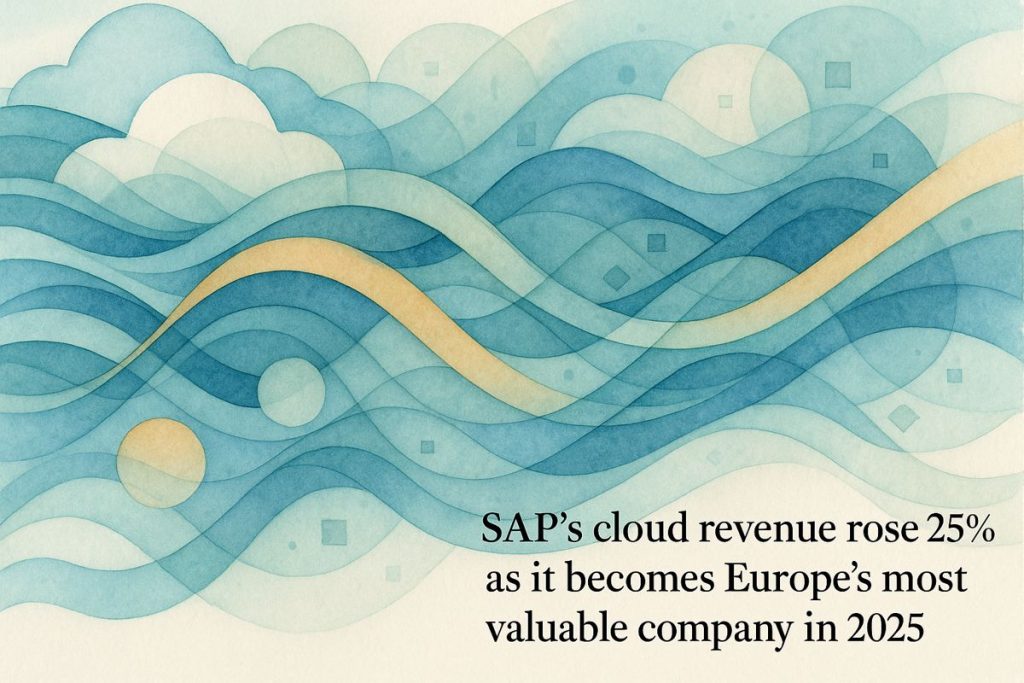SAP became Europe’s most valuable company in 2025 by growing its cloud business fast and using smart AI tools, making its software the backbone for global supply chains. Over 80% of its customers moved to the cloud, bringing in steady, reliable money and helping SAP stand strong even during tough times for other industries. While luxury brands and drug companies struggled with changing trends and global troubles, SAP quietly kept the world’s businesses running smoothly with invisible but powerful code and data. Thanks to this, SAP zoomed past famous rivals, showing that clever software can be more valuable than handbags or medicine.
Why has SAP become Europe’s most valuable company in 2025?
SAP became Europe’s most valuable company in 2025 due to its rapid cloud revenue growth, strong adoption of AI-driven solutions, and resilience to geopolitical risks. Its software powers global supply chains, with 80% of customers migrating to the cloud, driving recurring revenue and market dominance.
The View from the Summit: SAP’s Meteoric Climb
It’s 2025, and SAP isn’t just playing catch-up—they’re sprinting ahead, waving a €310 to €342 billion market capitalization banner like a rally flag at Le Mans. When I read that SAP had finally leapfrogged stalwarts like Novo Nordisk, LVMH, and even the formidable ASML, I’ll admit—I blinked, wondering if some analyst had gotten a decimal point tangled up. But no: as Eulerpool’s latest numbers attest, this wasn’t a rounding error. It’s a 40–50% surge in less than a year, a figure that tastes almost as bracing as a double espresso at 6 a.m.
Why? Because SAP has become the palimpsest upon which Europe’s digital ambitions are scribbled, not merely reacting to the zeitgeist, but shaping it. While luxury titans and pharma giants have been buffeted by shifting tastes, patent cliffs, and souring geopolitics, SAP’s software has become the unseen jigsaw piece keeping global supply chains from flying apart at the seams. How’s that for a metaphor—SAP as the glue in a continent-wide Rube Goldberg machine.
And yet, beneath the polished surface, there’s a curious hum. The sound of servers—a low, purposeful purr—reminding us that this is a company whose real value is invisible: code, logic, and data, not handbags or pills.
Cloud, AI, and the Hyperspectral Edge
Let’s cut through the marketing haze. In 2024, SAP’s cloud revenue didn’t just climb—it pole-vaulted 25% year-over-year, while the cloud backlog ballooned to €63.3 billion (about $68.5 billion, for those playing at home). Now, that’s not an idle boast; it’s a quantifiable trend. Christian Klein, SAP’s CEO (part strategist, part ringmaster), puts it bluntly: SAP’s biggest advantage is their “unique access to comprehensive business data sets.” That’s a phrase I used to dismiss—until I watched a client in the pharmaceutical sector run real-time compliance checks with S/4HANA and SAP IBP. It’s like giving a baroque orchestra a synthesizer—suddenly, centuries-old processes are humming with new frequencies.
But here’s a question—has all that AI talk translated into actual outcomes? Well, SAP’s latest suite isn’t just window dressing. S/4HANA, Integrated Business Planning, and the somewhat grandiloquent Billing and Revenue Innovation Management (BRIM) platform are now cloud-native, wielding predictive analytics and anomaly detection like a pair of surgical tongs. There’s an almost tactile sense to it: dashboards that flicker with hyperspectral data, supply chains that feel (to the harried operations manager) as smooth as brushed steel.
I recall one Friday afternoon in Q1 2025, when a midsize manufacturer’s CIO called. Their legacy ERP was buckling—orders queued up like taxis in a Moscow snowstorm. We migrated them to SAP’s cloud stack in 48 hours. Relief? Nah, more like exhilaration. Their head of ops said it “felt like opening the windows after a long, stuffy winter.” You don’t forget a phrase like that.
The Quiet Advantages: Geopolitics and Software’s Secret Armor
Let’s not kid ourselves—2024 was a year when tariffs, sanctions, and regulatory whiplash left more than a few bruises on Europe’s best. Pharmaceuticals fumbled with supply chain bottlenecks. Luxury brands shivered as Asian demand cooled. In comparison, SAP floated above it all, almost sphinx-like. Why? Code isn’t subject to customs inspections. Forget embargoes—try blockading a SaaS deployment.
This resilience isn’t just theory; Designative.info points out that SAP’s US customer base eclipses its German one, providing a buffer that’s as comforting as a thick wool sweater in November. And with over 17,000 enterprises worldwide on SAP systems by 2025, there’s safety in numbers. I had to stop and ask myself: is this finally the moment ERP becomes sexy? Maybe not. But indispensable? Absolutely.
It hasn’t all been smooth sailing. I remember mistakenly dismissing cloud migration as “just another IT fad” back in 2019—yep, that was a facepalm moment. Now, seeing that 80% of on-premise customers have crossed the Rubicon to cloud, I’m eating a fair serving of humble pie. That’s recurring revenue, not one-off license blips—a fact that makes analysts downright giddy.
The Competitive Palimpsest: Rivals, Restructuring, and Forward Glances
SAP’s real competitors—Hermès, ASML—are titans, but they’re playing a different game. Market value? Hermes may glitter, ASML may hum with precision, but neither has matched SAP’s acceleration (financecharts.com). And while the ERP market is projected to hit $70.3
